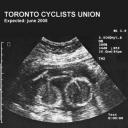UPDATED: see link to cyclist collision map below
Today in the Toronto Star and Car Advertiser, Tess Kalinowski weaves a compelling tale of the city’s moves of late: the passage of provisions by council to study the creation of a bikelane on Bloor/Danforth and elsewhere, and other progressive initiatives such as the painting of separate bike staging areas at red lights, ahead of the waiting cars, to increase cyclist visibility at intersections.
Hooray, we say.
The article in question occupies a full page in the front section of the paper, page A3. The page is labeled “Cyclists involved in collisions in 2005.” Intriguingly, the top third of the page comprises a map of the whole GTA (note to self: fix scanner see pdf of map here) with sites of the thousand or so crashes reported to police two years ago, arranged by type of injury. The middle third of the page is the article itself, which of course makes for worthwhile reading and which we append below in full. But what is remarkable in our opinion is the Star and Car Advertiser’s choice to position the photographs of several aggressively posed GM automobiles, complete with cartoon-style “BAM!” and “WHAM!” impact stars.
Now we know GM [that genetically-modified car company –ed.] is likely responsible for many, perhaps even a majority, of crashes and injuries to cyclists in the city. However to imply, as the Star and Car Advertiser does, that it is to blame for all such crashes, is surely a slander against the fine, albeit troubled, genetically modified car company. While our legal experts have yet to report back on this one, we anticipate an apology and retraction to follow in the paper, and/or news of a lawsuit.
Full text of story follows:
Cyclists chart a revolutionary path
Map: Bike accidents
City decision to look into Bloor-Danforth lanes could lead to fewer accidents, biking advocates say
Oct 29, 2007 04:30 AM
Tess Kalinowski
Transportation ReporterAs a law student, Kristen Courtney has enough to do without constant pain, a continual round of chiropractic and acupuncture appointments and a steady stream of insurance forms to fill out.
After seven biking accidents in Toronto, none of which she considers her fault, Courtney, 25, said, “I wake up in the morning and feel like I imagine my 56-year-old mother feels.”
Like thousands of cycling-accident victims, the University of Toronto student says the bike provisions passed by council last week, as part of a sustainable transportation plan, are as much about safety as they are about protecting the environment.
While fatalities are rare, a group of cycling advocates, including Bells on Bloor and Bikes on Bloor, say about 1,000 people each year report bike accident injuries to Toronto police. And they believe up to 90 per cent of injuries go unreported.
The best way to prevent cycling accidents is to build more bike lanes, say the activists, who complain that at the rate Toronto is moving, it will be 2070 before it meets its 2011 target to build 500 kilometres of such lanes.
But they acknowledge that the new transportation plan addresses one of the most pressing concerns. For the first time, Toronto has said it’s willing to look at an east-west bike route along Bloor-Danforth, from Victoria Park Ave. to Royal York Rd.
It’s only a study so far, but if it gets built it would be a significant victory for Toronto cyclists.
In a similarly supportive move, council directed city staff to investigate so-called “bike boxes” like those in Vancouver –designated areas at intersections that take cyclists out of a motorist’s blind spot and give them an advance position from which to make a left turn.
Research shows doing more to accommodate bikes on streets significantly reduces injuries.
Courtney’s worst accident, which messed up her neck, upper back and chest, happened last October and typifies one of the most common hazards to cyclists.
Riding along Queen St., she was “doored” by a woman who didn’t look before exiting her car. Courtney ran into the door, flew over it and landed on the streetcar tracks.
Major east-west routes like Queen St. and Bloor-Danforth are among the most dangerous routes for city cyclists; they’re busy and often dangerously narrow.
Even cycling advocate and city Councillor Glenn De Baeremaeker had hesitated to endorse bike lanes on these routes, a reluctance compounded by that of merchants and motorists who worry about traffic congestion and the loss of on-street parking to bike lanes.
But De Baeremaeker said he changed his mind about Bloor-Danforth. After travelling it on his bike and in a car, he concluded the cycling traffic is already significant on the route.
“Despite my own initial fears as a cyclist, that is a main entranceway into the city. The best way is to formalize what people are already doing,” he said. The second-term councillor is among those who believe last week’s passage of the plan sounds the death knell for opposition to cycling at city hall.
Asked why you would need to bike on Bloor St., Courtney responded, “Why would you ever drive on Bloor when there’s a subway?”
Planners know bike lanes can be a difficult sell for merchants and residents. Whereas Dundas St. – which has a bike lane – has lots of residential property, Bloor is mostly commercial, said Daniel Egan, Toronto manager of cycling and pedestrian infrastructure.
He said the city will consider lots of options on Bloor St., including rush-hour bike lanes or a bikeway, which could be a wide curb lane with “sharrows,” street markings placed on shared lanes (typically two chevrons and a bike symbol) that show where cyclists should be situated on the road.
“We won’t know until we take a look at it, and council will say at the end of the day what they want to support,” Egan said.
As for the city’s latest move, “It’s a step forward but in the grand scheme of things this is still only a report,” said environmental lawyer Albert Koehl. “Is the pace of government response equal to the urgency of the problem? The answer is clearly no.”





